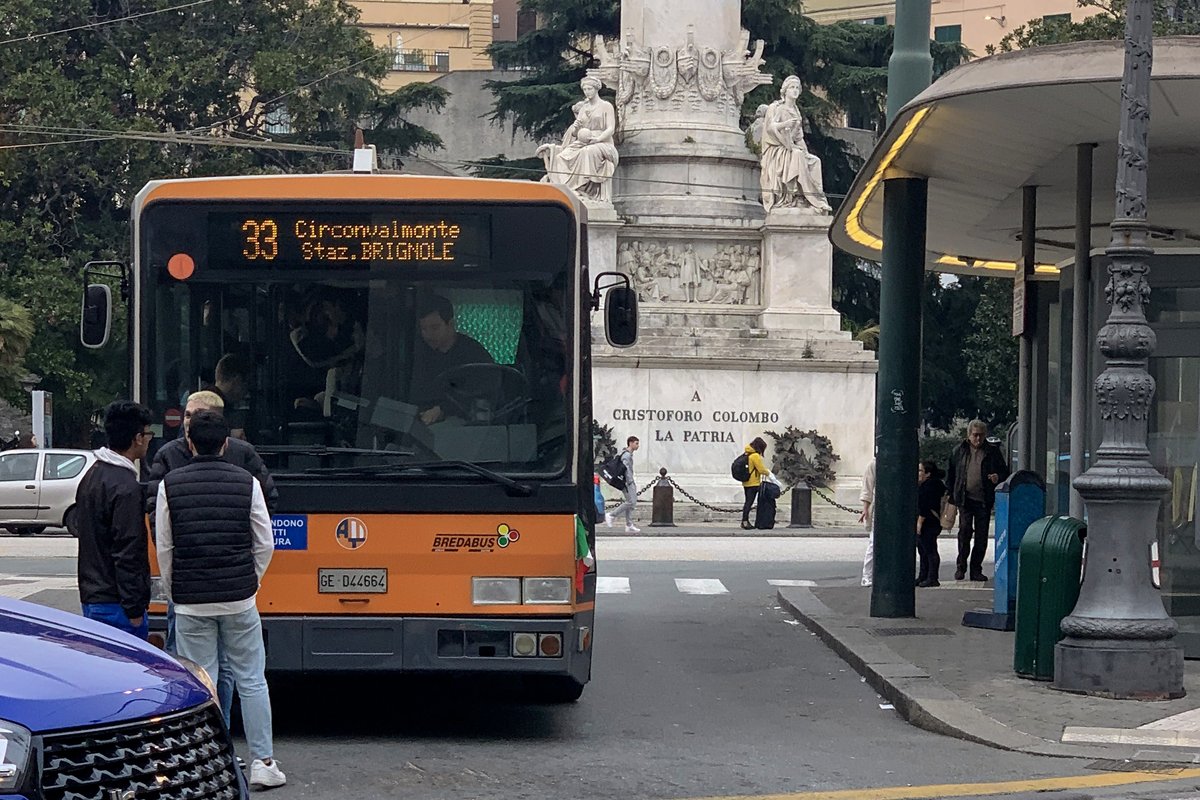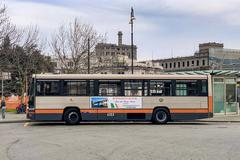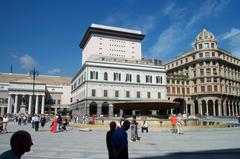
Piazza De Ferrari Genoa: Visiting Hours, Tickets, and Historical Sites Guide
Date: 15/06/2025
Introduction to Piazza De Ferrari
Piazza De Ferrari sits at the heart of Genoa, Italy, functioning as the city’s main civic and cultural hub. Renowned for its monumental bronze fountain—an emblematic modernist work designed by Giuseppe Crosa di Vergagni in 1936—the piazza is a showcase of Genoa’s rich history, architectural diversity, and vibrant urban life. Surrounded by a captivating blend of medieval, Renaissance, neoclassical, and Art Nouveau structures, including the Palazzo Ducale and Teatro Carlo Felice, the square is where Genoa’s storied past meets its dynamic present.
This guide provides all the essential information for travelers: visiting hours, ticketing details for nearby attractions, accessibility tips, safety advice, and highlights of the area’s most significant historical and cultural sites. Whether you’re an architecture enthusiast, a culture seeker, or a casual explorer, use this comprehensive resource to make the most of your visit to one of Italy’s most iconic urban spaces (Astoria Genova; TravelSetu; Visit Genoa).
Table of Contents
- Introduction
- Architectural Landmarks and Styles
- Cultural Significance and Urban Life
- Practical Visitor Insights
- Nearby Attractions and Activities
- Frequently Asked Questions (FAQ)
- Conclusion
- References
Architectural Landmarks and Styles
The Piazza’s Urban Fabric
Piazza De Ferrari is Genoa’s main civic space, where the layers of the city’s architectural history are on full display. The surrounding buildings reflect an eclectic mix of styles—from medieval and Renaissance to neoclassical and Art Nouveau—underscoring Genoa’s evolution as a maritime republic and modern metropolis (Astoria Genova; TravelSetu).
The Fountain: Modernist Symbolism
The piazza’s monumental bronze fountain, designed in 1936 by Giuseppe Crosa di Vergagni, features a central basin, powerful jets, and cascading water that create a sense of movement and vitality. This iconic fountain is not only a visual focal point but also a symbol of Genoa’s resilience and civic pride (Astoria Genova; Visit Genoa).
Palazzo Ducale (Ducal Palace)
Overlooking the square, the Palazzo Ducale dates back to the 14th century and originally served as the residence of Genoa’s doges. Its Gothic-Renaissance façade and impressive interiors now host major art exhibitions and cultural events. Entrance to exhibitions requires a ticket, with prices varying based on the event (Astoria Genova).
Teatro Carlo Felice
Built in 1828, the Carlo Felice Theatre is one of Italy’s leading opera houses. Severely damaged during World War II, it was rebuilt and reopened in 1991 with a modern, acoustically advanced interior. The theater offers regular performances and guided tours—tickets and schedules are available on its official website (Astoria Genova).
Palazzo della Nuova Borsa (New Stock Exchange)
Inaugurated in 1912, this Art Nouveau masterpiece by Dario Carbone features lavish decoration and symbolizes Genoa’s economic optimism of the early 20th century. Today, it houses the Chamber of Commerce (Astoria Genova; TravelSetu).
Palazzo della Regione Liguria
Completed in 1912 by Marcello Piacentini, this neoclassical building originally served the Bank of Genoa and now houses the regional government. Its stately façade and courtyard are notable architectural highlights (Astoria Genova).
Palazzo del Credito Italiano
Built in 1895 by Gino Coppedè, the Palazzo del Credito Italiano showcases eclectic architectural motifs and was once the headquarters of Credito Italiano (now UniCredit) (Astoria Genova).
Ligustica Academy of Fine Arts
Founded in 1751, this historic academy faces Palazzo Ducale and is a center for art education, displaying works by prominent Ligurian artists (Astoria Genova).
Cultural Significance and Urban Life
Civic and Social Heartbeat
Piazza De Ferrari is Genoa’s premier gathering place for events, celebrations, and demonstrations. Its central location connects the old town’s narrow “caruggi” alleys with the city’s elegant boulevards, making it a natural starting point for exploring Genoa’s UNESCO-listed sites (Bimbeinviaggio).
Symbol of Genoese Identity
Named after Raffaele De Ferrari, a prominent 19th-century banker and philanthropist, the piazza embodies the city’s spirit of civic generosity and public pride (Bimbeinviaggio).
Cultural Institutions and Events
Major institutions like Teatro Carlo Felice, the Ligustica Academy, and Palazzo Ducale ensure a lively calendar of cultural events. The piazza’s proximity to Via Garibaldi and the Palazzi dei Rolli (UNESCO World Heritage) further enhances its cultural appeal (Oneday-Itinerary).
Urban Renewal and Digital Innovation
Recent decades have seen significant enhancements to the square, including pedestrianization and the integration of digital experiences like mobile apps and virtual tours for visitors (Visit Genoa).
Practical Visitor Insights
Piazza De Ferrari Visiting Hours and Tickets
- The square: Open 24/7, free of charge (Nomads Travel Guide).
- Palazzo Ducale: Open Tuesday–Sunday, 10:00–19:00. Tickets required for exhibitions.
- Teatro Carlo Felice: Performances and guided tours require tickets; check schedules online.
- Ligustica Academy: Open during exhibitions or by appointment.
Accessibility and Navigation
- Public Transport: The De Ferrari metro station is directly beneath the square, with connections to main train stations and numerous buses.
- On Foot: The square is pedestrian-friendly and easily navigated.
- By Car: Central driving is discouraged due to restricted traffic zones; use nearby parking garages if necessary.
Facilities
- Restrooms: Available in nearby cafés or cultural venues (for ticket holders).
- Wi-Fi: Free public Wi-Fi available in the city center.
- Seating: Limited benches; most people use the steps by the fountain or café seating.
- Accessibility: The square is flat and suitable for wheelchairs and strollers.
Safety
The area is generally safe, with regular police patrols. As in any city, stay vigilant for pickpockets in crowded situations (Bimbeinviaggio).
Best Times to Visit
- Daytime: Busiest between 10:00 and 19:00—ideal for people-watching.
- Evening: The illuminated fountain creates a picturesque setting.
- Quieter Moments: Early morning or late evening visits offer tranquility and better photo opportunities.
Nearby Attractions and Activities
- Via Garibaldi: Home to Renaissance and Baroque palaces—UNESCO World Heritage Site (Savoring Italy).
- Cattedrale di San Lorenzo: Genoa’s 12th-century cathedral with a unique marble façade (Savoring Italy).
- Porta Soprana: Medieval gatehouse and city wall remains (The Crazy Tourist).
- Palazzo Spinola and Musei di Strada Nuova: Museums featuring works by Caravaggio and Van Dyck (Savoring Italy).
- Old Port (Porto Antico): Waterfront area with attractions like the aquarium and panoramic lift (Savoring Italy).
- Galleria Mazzini: Historic 19th-century arcade with shops and cafés.
Cultural Experiences:
- Attend a performance or tour at Teatro Carlo Felice (TravelSetu).
- Explore art exhibitions at Palazzo Ducale (Amongst Romans).
- Enjoy an aperitivo by the fountain or at nearby cafés (Amongst Romans).
Photography:
Capture the bustling life, architectural details, and the illuminated fountain—morning and evening light are especially photogenic.
Frequently Asked Questions (FAQ)
Q: What are Piazza De Ferrari’s visiting hours?
A: The square is open 24/7, free of charge.
Q: Is there an entrance fee?
A: No, the piazza is a public space; nearby attractions may charge admission.
Q: How do I get there?
A: The De Ferrari metro station is directly beneath the square; various bus lines connect to the area.
Q: Are guided tours available?
A: Yes, several companies offer walking tours starting from the square.
Q: Is the square accessible for visitors with mobility challenges?
A: Yes, the square is flat and wheelchair accessible; check individual attractions for specific access details.
Conclusion
Piazza De Ferrari is the ideal gateway to Genoa’s multifaceted heritage—a place where the city’s historical grandeur meets a lively, modern atmosphere. With its stunning architecture, central fountain, and proximity to Genoa’s top attractions, the square invites exploration at any hour. Whether you’re attending a performance, joining a guided tour, or simply relaxing by the fountain, Piazza De Ferrari offers a rich encounter with Genoa’s spirit and culture.
For the latest information on visiting hours, ticketing, and events, consult official tourism resources and consider using digital travel apps for enhanced experiences.
References
- Astoria Genova, 2024, What to See in Piazza De Ferrari in Genoa
- TravelSetu, 2024, Piazza De Ferrari Tourism History
- Visit Genoa, 2024, Piazza De Ferrari
- Bimbeinviaggio, 2024, Discovering Historical Centre Genoa Guide
- Nomads Travel Guide, 2024, Piazza De Ferrari
- The Crazy Tourist, 2024, 15 Best Things to Do in Genoa, Italy
- ItalyScapes, 2024, Piazza De Ferrari




































































































